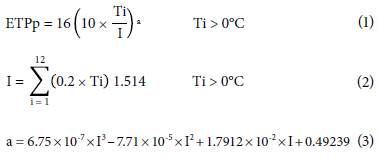Introduction
A higher water demand coupled with water supply constraints influence water availability for various sectors including agriculture. The rational and optimized use of water in the agricultural sector requires planning within the various systems of production, ensuring a continuous supply and increased water productivity for each crop (Souza et al., 2013).
Conducting a survey on the climatic characteristics of the place where one intends to begin or expand agricultural production is extremely important, since it aims to describe atmospheric phenomena on a temporal scale, identifying critical periods for decision-making in crop management. Based on this, the water availability of a region can be quantified by the climatological water balance (CWB) (Santos et al, 2010) that shows seasonal variations through relationships between the inputs and outputs of a control condition, mainly rainfall and potential evapotranspiration (Castro et ah, 2010).
Thus, CWB is an appropriate methodology for classifying dry and rainy periods of a locality or region, since it assumes the indication of water deficit or surplus in the soil and may consider other climatic variables besides the total rainfall regimen (Lopes et ah, 2017). This knowledge is important for the management of crops located in the region, especially cacao grown under shade trees, cabruca cocoa, which is the most significant and potential cacao in southern Bahia (Chiapetti, 2018).
Cacao is a typical plant of tropical climate and demands ample water. It is very sensitive to the lack of soil moisture (Souza et ah, 2009). Additionally, studies on the requirements for supplementary irrigation for this crop in humid regions are still incipient. Thus, in periods of water deficit the implementation of a supplementary irrigation system might have benefits ensuring the sustainability of the system of production over the years. However, the decision to irrigate must also consider other technical and socioeconomic aspects.
The aim of this study was to perform a climatic characterization and to evaluate the need for supplementary irrigation for cacao crops in the southern region of the state of Bahia (Brazil).
Materials and methods
For this study, historical data (2001-2017) on rainfall, mean, maximum and minimum air temperatures, relative humidity, wind speed at 10 m height, and maximum wind speed were obtained. These are available at the weather station of the Executive Commission for Cacao Cultivation Planning (CEPLAC), located in southern Bahia between the municipalities of Ilheus and Itabuna. The climate of the region is tropical rainforest Af, according to the Koppen classification (Alvares et ah, 2013), with a mean annual rainfall of 1,830 mm, mean annual relative humidity of 80%, and mean air temperature of 23.5°C. The daily potential evapotranspiration estimated by the modified method of Penman is 3.42 mm/d (Tagliaferre et ah, 2012).
To develop the database of this study, analyses were performed considering the values of the accumulated monthly variables of the historical series of climatic data. The accumulated monthly totals were divided by the number of years of observation, to obtain the mean monthly values of the variables, including daily rainfall. Results were subjected to descriptive statistical analyses, aiming to establish the mean values and the variation around the mean score (standard deviation) of all variables for each month during the period from 2001 to 2017.
Mean rainfall and mean air temperature values were used to calculate the standard potential evapotranspiration (ETPp) for each month by means of the Thornthwaite method (Thornthwaite and Mather, 1955) (Eq.1 to 3).
where: Ti is the mean monthly temperature (°C), I is an index that expresses the heat level of the region, and exponent "a", in function of I, is also a regional thermal index.
To convert ETPp to potential evapotranspiration (ETP), a correction for days of the month and photoperiod was performed. The photoperiod was calculated as a function of the site's latitude and solar declination (Eq. 4).
where: N is the photoperiod during the hours of a given day.
CWB for the historical series was calculated according to a methodology proposed by Thornthwaite and Mather (1955), assuming a storage capacity of water available in the soil of 50 mm. The need for supplementary irrigation for cacao cultivation was based on the total monthly water deficit. We estimated that the number of months needed for supplementary irrigation would be conditioned on the total monthly water deficit being equal to or higher than 250 mm - a range defined by Despontin (2018) with a potential risk that could harm cacao crops. Considering the 17-year historical series, when converting this information into mean values, the main condition was that the value for monthly water deficit was equal to or higher than 14.7 mm.
Results and discussion
The mean values and standard deviation for monthly and daily rainfall from the CEPLAC weather station for 2001 to 2017 are presented in Table 1.
TABLE 1 Descriptive statistics of monthly and daily rainfall for the period from 2001 to 2017.
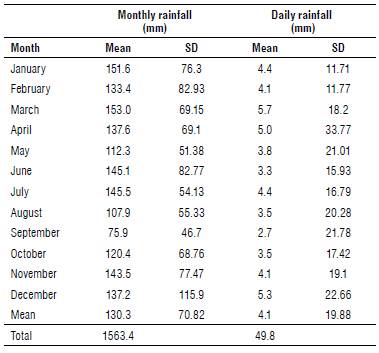
SD - standard deviation.
Regarding the annual distribution, the climate of the region showed well-distributed rainfall throughout the year. The months with the highest and lowest rainfalls were March (late rainy season and September (late dry season, having 153.0 and 75.9 mm of precipitation, respectively. Thus, using this data interpretation, by adding up the rainfall volumes for the rainy season months (December, January, February, and March), a higher value (17.5%) was observed in relation to the dry season months (June, July, August, and September).
Regarding the standard deviation of the mean daily rainfall, it is possible to observe that April showed a higher value, indicating that this month showed a larger amplitude of data in relation to the mean, and was different from January and February, which showed the lowest values. These results corroborate those found by Correa and Galvani (2017), who also found higher standard deviation values for the transition period between the rainy and dry seasons.
Rainfall is the meteorological element that shows the greatest variability both in quantity and in monthly and annual distribution, especially in tropical regions. Rainfall variations occur due to the behavior of regional atmospheric circulation throughout the year, along with local or regional geographic factors (Almeida et al., 2017). When analyzing the spatiality of rainfalls in southeastern Bahia from 1978 to 2008, Santos and França (2011) found an east-west variation of quite distinct rainfall values, in the range of 1,000 to 2,000 mm per year. The coastal range had the highest values, confirmed by the present study.
Table 1 shows that the region has high annual rainfall, benefiting cacao tree culture since the crop has a minimum water demand of 1,200 mm. In addition to needing high annual rainfall, cacao trees require the water supply to be distributed throughout the year in order to meet its needs at different phenological stages, especially from anthesis to fruit maturation, with a required monthly rainfall of approximately 100 mm (Souza et al., 2009). Based on this assumption, only September showed a rainfall distribution lower than the ideal one. This requires more accurate monitoring of cacao crops in the southern region of the state regarding plant disturbances. In addition, specific studies related to the presence of water deficit are also needed, since deficits can damage productivity.
Table 2 shows the mean monthly values for mean, maximum and minimum air temperatures. The mean temperatures were below 22°C from June to September (dry season period), and August was the month with the lowest maximum and minimum temperature, - 26.6 and 17.7°C, respectively.
TABLE 2 Descriptive statistics for mean, maximum and minimum air temperatures for the period from 2001 to 2017.
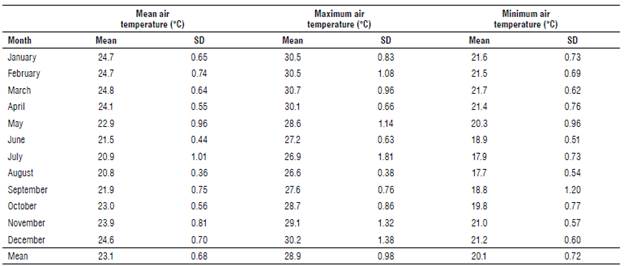
SD - standard deviation.
The rainy season had the highest mean temperatures of the year, especially in March, which had the highest mean rainfall (Tab. 1). This result is associated with a lack of seasonality of the phenomenon of southern Bahia with no well-defined seasons, especially in the late rainy season, which can have torrential rain on sunny days (with short intervals). A torrential rain increases soil saturation and consequently causes a delay or suppression of cacao flowering. This is a common occurrence in the region (Santos and Sodre, 2017).
Temperature and rainfall are the climatic elements that most influence the growth and production of cacao trees. Since rainfall can be supplemented by irrigation, several researchers claim that temperature, among all climatic elements, is the most critical for cacao growth and production, and this affects vegetative growth, flowering, and fruit development (Almeida and Valle, 2007).
The ideal mean temperature for good development and production of cacao is up to 25°C, and the absolute minimum temperature should not be below 10°C with a minimum mean above 15.5°C in the coldest month (Souza et al., 2009). The values observed in Table 2 are within the range recommended for cacao cultivation, confirming an aptitude for cacao cultivation in the region (Almeida and Valle, 2007).
Table 3 shows the mean monthly values and standard deviation for the variables of atmospheric relative humidity, wind speed at 10 m height, and maximum wind speed. It was obvious that the atmospheric relative humidity showed little variation for the means between months. The month with the highest mean value for humidity was June (early dry season), and the one with the lowest mean value was February (mid-wet season) with values of 92.8 and 88.9%, respectively, and a difference of 3.93%.
TABLE 3 Descriptive statistics for atmospheric relative humidity, wind speed at 10 m height, and maximum wind speed for the period from 2001 to
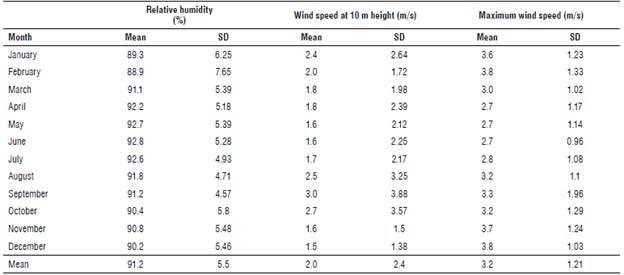
SD - standard deviation.
There is no scientific evidence for direct effects of relative humidity on the physiology of cacao plants. However, this climatic variable directly influences the development of fungal diseases, such as brown rot (Phytophthora spp.) and witches' broom (Moniliophthora perniciosa) disease (Bridgemohan and Mohammed, 2019). During rainy years, these diseases occur frequently in several cacao-producing cities in the southern region of the state, but particularly when the relative humidity of the air exceeds 80%, the diseases are regularly observed during all months of the year.
This shows that the region has an environment favorable to the development of such diseases.
The mean values for the maximum wind speeds were high during the rainy season and February and December were the months with the highest value (3.8 m s-1). April, May and June were the months with the lowest values (2.7 m s-1). This result confirms the study of Pereira et al. (2016), who found that June showed the lowest value for maximum wind speed when evaluating the mean monthly data of climatic variables.
Amongst the climatic variables, winds can be problematic for cacao trees as they can cause great damage to crops, resembling what happens with most cultivated plants. The action of high wind speeds hinders the formation and maintenance of cacao trees, since the young plants are the most sensitive. Serra (2004) states that cold winds can cause cacao leaves to burn, thus reducing the photosynthetic area of the plant and its yield. Furthermore, according to this author, the occurrence of strong winds causes the leaves to be torn and flowers to fall. The installation of windbreaks is the most appropriate way to control such damage.
Windbreaks are recommended when the wind speed at 10 m height is greater than 2.5 m s-1, a situation that occurred only in October (2.7 m s-1).
However, in the cacao system of production that prevailed in the southern part of the state, winds are not usually a problem for crop development. Cacao trees are grown in a system commonly called cabruca, where they are planted under large trees remnant of the Atlantic Forest, and these large trees act as natural windbreaks (Köppen et al, 2017).
Figures 1 and 2 show histograms for water deficit and surplus obtained by the CWB month by month for the historical series from 2001 to 2017. Only the year 2007 had no deficit for any month, whereas 2015 had the highest number of months when water loss was higher than the precipitation with seven months of deficit (average of 95.0 mm), especially in November. The year 2015 can be considered an atypical period in the historical series, since southern Bahia had a prolonged rainfall shortage that generated high water stress in plants, especially during the early rainy season (fundamental for fruit picking) and directly compromising the production planning for cacao crops.
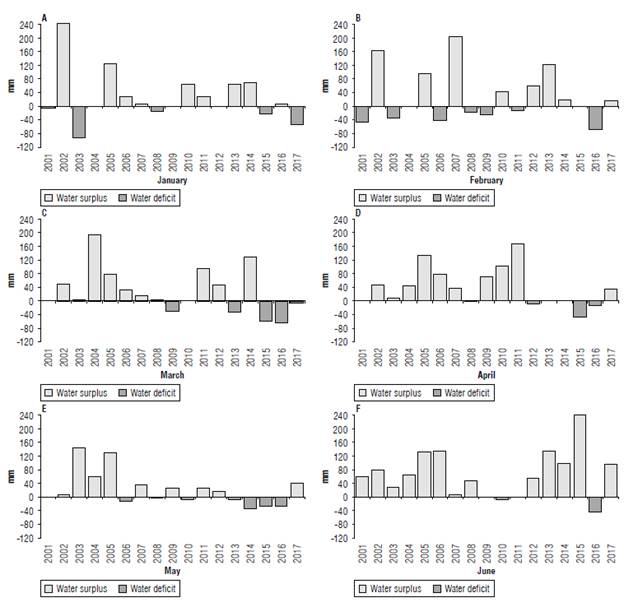
FIGURE 1 Histograms for water deficit and surpluses obtained by the CWB from January to June for the period from 2001 to 2017.
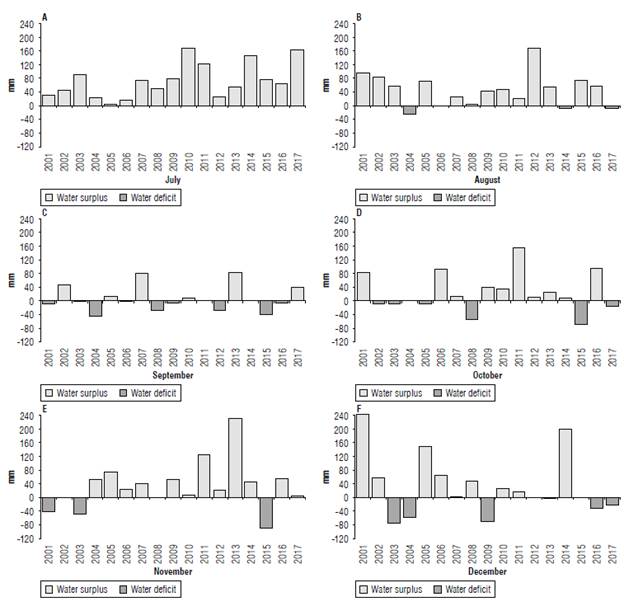
FIGURE 2 Histograms for water deficits and surpluses obtained by the CWB from July to December for the period from 2001 to 2017.
All histograms exhibited periods of water deficit and surplus throughout the evaluated years (except for July), demonstrating a non-homogeneous tendency of the climate of the region. One year a month could show high water deficit, and the next it could be quite rainy. This fact stands out in February, as it showed the largest deficit between months in the mean of the years, with values of 47.0 mm (2001) and 43.5 mm (2006). In the subsequent years (2002 and 2007), this was the month that displayed the highest mean values of water surplus (166.4 and 207.5 mm, respectively).
When this behavior is observed in a historical series, there is an indication that the distribution of the phenomenon is discontinuous, deviating from an expected pattern. Temporal discontinuous behavior in an historical series of climatic data may be associated with the influence of atypical periods of distribution and/or with a natural condition of the phenomenon under study. When the second condition is the predominant one, special attention should be paid to February since cacao trees under conditions of low water storage in the soil show a reduction in fruit production during this period, providing fewer fruits at the end of the main harvest (Santos and Sodre, 2017). A reduction in fruit production in cacao is associated with physiological and metabolic changes suffered by plants under water stress conditions. Water stress affects the internal availability of water in plants, translocation of assimilates, source-sink relationships and the development of flowers and fruits (Bridgemohan and Mohammed, 2019).
Throughout the historical series, February and December are the months indicated for supplementary irrigation, since they were the only ones with total water deficit above the recommended limit, 253.2 mm (Fig. 1) and 255.4 mm (Fig. 2), as well as mean water deficits, 14.9 mm and 15.0 mm, respectively. As observed in Table 1, these months showed on average low to medium rainfall with relation to the other months. They also displayed an absence of seasonality, i.e., a behavior of high variation between years (mainly February). This impairs crop development at fundamental phenological phases and highlights the importance of the implementation of a supplementary irrigation system for cacao trees in order to provide water during periods of high-water deficit.
February corresponds to the end of the harvest and the period when the cacao tree is producing new leaves and flowers and is physiologically preparing to produce the second crop of the year (known as safra témpora). Thus, soil water deficit during this month may reduce the total yield and cause young fruit mummification in adult plants, premature leaf fall, basal leaf yellowing, and reduced growth (Carr and Lockwood, 2011).
Santos and Sodré (2017) state that the constant water deficit during the early part of the rainy season (which involves a large period in December) over the years makes the cacao fruit vulnerable to a disorder known as "cherelle wilt". According to the authors, this disorder usually occurs in cacao plantations in southern Bahia in the first 90 d after fruit picking and reaches its maximum state between 40 and 70 d after flower fertilization. The disorder causes a nutritional imbalance in the plant. The authors also state that during months of high-water deficit (December), soil water storage may remain close to or below 5% of the water available to cacao plants and may result in fruits with disturbances.
It is important to consider that investment in a supplementary irrigation system in humid and subhumid regions, such as the cacao plantations considered in this study, may be economically viable for applying the fertigation technique, allowing a greater technological level for the crop production to be reached. This could result in increased productivity and fertilizer application efficiency and reduced labor costs. Additionally, the use of this technique may ensure production stability over the years.
Overall, CWB proved to be a very important technique for planning cacao cultivation. This is relevant for indicating the need for supplementary irrigation in some periods of water deficit in the region. However, further studies are recommended to estimate the necessary water level and how it will be distributed to fill this deficit during dry periods. Such studies will generate pioneering and interpretable information on the different phenological stages of cacao tree cultivated under the cabruca system for the various producers in the southern region of Bahia.
Conclusions
In general, southern Bahia has a favorable climate for the cultivation of cacao. However, this pattern does not continue throughout the historical series of climatic data, rather the series shows a temporal discontinuity during some months, especially in February. The main months requiring supplementary irrigation for cacao cultivation grown in southern Bahia were February and December.













